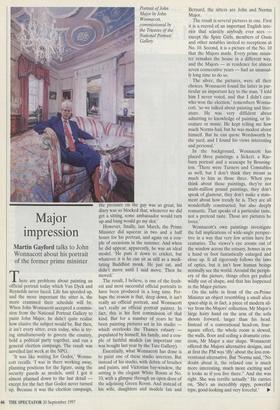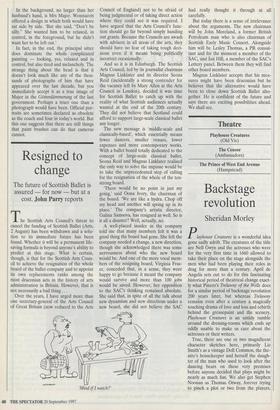Portrait of John Major by John Wonnacott, commissioned by the
Trustees of the National Portrait Gallery
Major impression
Martin Gayford talks to John Wonnacott about his portrait of the former prime minister There are problems about painting an official portrait today which Van Dyck and Reynolds never faced. Life has speeded up, and the more important the sitter is, the more crammed their schedule will be. When John Wonnacott accepted a commis- sion from the National Portrait Gallery to paint John Major, he didn't quite realise how elusive the subject would be. But then, it isn't every sitter, even today, who is try- ing simultaneously to govern the country, hold a political party together, and run a general election campaign. The result was unveiled last week at the NPG.
`It was like waiting for Godot,' Wonna- cott recalls. `I was in there working away, planning positions for the figure, using the security guards as models, until I got it almost planned down to the last detail except for the fact that Godot never turned up. Because it was the election campaign, the pressure on the guy was so great, his diary was so blocked that, whenever we did get a sitting, some ambassador would turn up and bang would go my slot.'
However, finally, last March, the Prime Minister did squeeze in two and a half hours for his portrait, and again on a cou- ple of occasions in the summer. And when he did appear, apparently, he was an ideal model. 'He puts it down to cricket, but whatever it is he can sit as still as a medi- tating Buddhist monk. He just sat, and didn't move until I said move. Then he moved.'
The result, I believe, is one of the fresh- est and most successful official portraits to have been produced in a long time. Per- haps the reason is that, deep down, it isn't really an official portrait, and Wonnacott isn't really an official portrait painter. In fact, this is his first commission of that kind. But for a number of years he has been painting pictures set in his studio which overlooks the Thames estuary populated by himself, his family, and a cou- ple of faithful models (an important one was bought last year by the Tate Gallery). Essentially, what Wonnacott has done is to paint one of these studio interiors. But instead of his studio, with debris of brushes and paints, and Victorian bay-window, the setting is the elegant White Room at No. 10, with a glimpse through an open door of the adjoining Green Room. And instead of his wife, daughters and models Ian and Bernard, the sitters are John and Norma Major.
The result is several pictures in one. First it is a record of an important English inte- rior that scarcely anybody ever sees except the Spice Girls, members of Oasis and other notables invited to receptions at No. 10. Second, it is a picture of the No. 10 that the Majors made. Every prime minis- ter remakes the house in a different way, and the Majors — in residence for almost seven consecutive years — had an unusual- ly long time to do so.
The silver, the pictures, were all their choices. Wonnacott found the latter in par- ticular an important key to the man. 'I told him I never voted, and that I didn't care who won the election,' remembers Wonna- cott, 'so we talked about painting and liter- ature. He was very diffident about admitting to knowledge of painting, or lit- erature or music. He kept telling me how much Norma had, but he was modest about himself. But he can quote Wordsworth by the yard, and I found his views interesting and personal.'
In the background, Wonnacott has placed three paintings: a Sickert, a Rae- burn portrait and a seascape by Bonning- ton. 'There were Turners and Constables as well, but I don't think they meant as much to him as those three. When you think about those paintings, they're not multi-million pound paintings, they don't speak of glamour, they don't make a state- ment about how trendy he is. They are all wonderfully constructed, but also deeply romantic. That speaks of a particular taste, not a pretend taste. Those are pictures he loves.'
Wonnacott's own paintings investigate the full implications of wide-angle perspec- tive in a way that very few artists have for centuries. The viewer's eye zooms out of the window across the estuary, homes in on a hand or foot fantastically enlarged and close up. It all rigorously follows the laws of optics, but it isn't how human beings normally see the world. Around the periph- ery of the picture, things often get pulled wildly out of shape, and that has happened in the Major picture.
On the table in front of the ex-Prime Minister an object resembling a small alien space-ship is, in fact, a piece of modern sil- ver from the Majors' collection. Mr Major's large hairy hand on the arm of the sofa shoots forward, larger than his head. Instead of a conventional head-on, four- square effect, the whole room is slewed, the walls, floor and ceiling a dramatic criss- cross, Mr Major a star shape. Wonnacott offered the Majors alternative designs, and at first the PM was 'iffy' about the less con- ventional alternative. But 'Norma said, "No doubt about it, the relaxed one is much more interesting, much more exciting and it looks as if you live there." And she was right. She was terrific actually.' He carries on, 'She's an incredibly zippy, powerful type, good-looking and very forceful.' ► In the background, no larger than her husband's hand, is Mrs Major. Wonnacott offered a design in which both would have sat side by side. 'But she said, "Don't be silly." She wanted him to be relaxed, in control, in the foreground, but he didn't want her to be left out.'
In fact, in the end, the principal sitter does dominate the whole complicated painting — looking, yes, relaxed and in control, but also tired and melancholy. The strange thing about the head is that it doesn't look much like any of the thou- sands of photographs of him that have appeared over the last decade, but you immediately accept it as a true image of Major in the GOtterdammerung of the last government. Perhaps a truer one than a photograph would have been. Official por- traits are sometimes declared as obsolete as the coach and four in today's world. But this one suggests that there are still things that paint brushes can do that cameras cannot.



































































 Previous page
Previous page